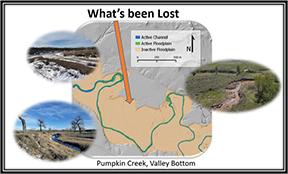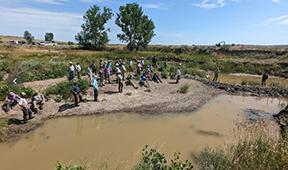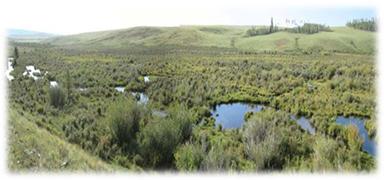You are viewing ARCHIVED content published online before January 20, 2025. Please note that this content is NOT UPDATED, and links may not work. Additionally, any previously issued diversity, equity, inclusion or gender-related guidance on this webpage should be considered rescinded. For current information, visit https://www.blm.gov/blog.
Teaching While Doing - Low-Tech Process-Based Restoration of Riverscapes Workshop: Building Partnerships and Technical Capacity to Improve Riverscape Health

Riverscape: Without structural elements
to capture, spread, and store
water/sediment across the valley bottom,
this incised channel functions like a ditch.
Nearly all water and sediment inputs are
rapidly transported out of the system,
rather than distributed laterally across the
valley bottom, where it historically helped
sustain high water tables, saturated soils,
and extensive riparian-wetland areas. As
a result, the natural “sponge” has dried
and most of the riparian-wetland habitat
has converted to upland plant communities.
By Alden Shallcross, State Lead - Montana/Dakotas Aquatic Habitat Management Program, Christina Stuart, Fish Biologist – Miles City Field Office
Christopher Morris, Hydrologist – Miles City Field Office
Dan Fox, Assistant Field Manager (Resources) – Miles City Field Office
Riverscapes—the connected floodplain and channel habitats that together make up valley bottoms—are disproportionately important parts of the landscape that are increasingly prioritized for restoration.
When healthy, the associated riparian-wetland and aquatic areas provide a wide array of ecosystem services that support our multiple use management objectives.
Where they have been impaired by historic management practices, however, ecological processes that historically maintained site attributes have correspondingly broken down. The resulting changes have been so severe in many areas that the systems no longer look or function like they did historically, even where management has improved.
Traditional restoration practices such as the use of earth moving equipment are too costly to be applied at an ecologically meaningful scale (among other issues). Instead, low-tech methods are being used to mimic, promote, and sustain the keystone processes which create and maintain healthier riverscapes.
To facilitate broader use of these methods, the Montana/Dakotas State and Miles City Field Offices hosted a Low-Tech Process-Based Restoration (LTPBR) of Riverscapes Workshop August 9-11 at Pumpkin Creek. Participants learned how to use ‘low-tech’ process-based approaches for restoring streams and their associated riparian areas.

constructed by each of the sub-teams, in
accordance with the Pumpkin Creek Plan
and Design Report.
Pumpkin Creek is a perennial prairie stream in southeastern Montana. As with most valley bottoms in the region, the historic removal of beaver, livestock grazing, and subsequent channel incision have impaired the system’s health. Despite years of improved grazing management, it remains in a degraded state and recovery is exceedingly slow.

retain water and sediment, which creates and maintains
riparian-wetland and aquatic habitat throughout the entire
valley bottom. Riverscapes in this condition act like a
natural sponge, soaking up water to dampen floods,
where it can later be released downstream. Such a
system exhibits frequent and extensive surface water
inundation throughout most/all the year, including during
periods of low flow or even drought.
The BLM coordinated with Utah State University and the Riverscapes Consortium to write a restoration planning and design report which guided workshop efforts and discussions. It will also be used to restore restore the rest of Pumpkin Creek, and serve as a template for designing other projects. This report, related permits, and other project information are available on the Pumpkin Creek Workshop & Project Webpage.
More than 30 participants from the BLM and other state, local and federal agencies and organizations. attended. By bringing partners together to “learn by doing,” we build both technical skills and stronger working relationships.
Before the workshop, participants completed pre-recorded lessons on the underlying science; attended two days of classroom lecture with corresponding exercises; listened to rancher Jay Wilde explain his experience using these tools to restore perennial flow on his working land; and spent a day in the field constructing a variety of structures.
Close coordination between the BLM Miles City fire/fuels and resource programs was critical to the success of this effort. For example, the fuels program removed encroaching conifer from a nearby fuels treatment to minimize fire hazards. However, rather than burning the slash, they cut and piled it according to the guidance of BLM resources staff, who subsequently transported the woody material to Pumpkin Creek, where it was used to construct BDAs and PALs during the workshop and subsequent restoration efforts.
Related Stories
- Nine years of partnership pays off: Fitzhugh Creek Meadow restoration achieves dramatic results
- Lake Havasu Fisheries Improvement Program: Thirty years of stewardship, science, and community
- Monument map earns ‘finalist’ honors in global GIS awards
- BLM Fire and National Conservation Lands managers collaborate to meet shared goals
- BLM Eastern States enhances campsites on Black Duck Lake
